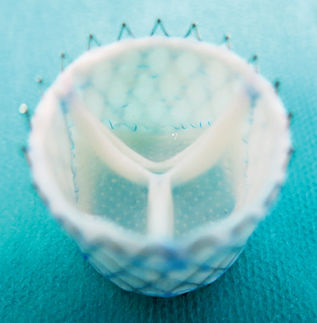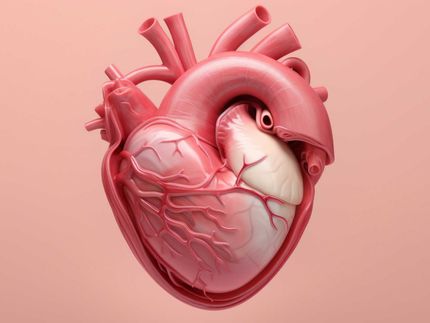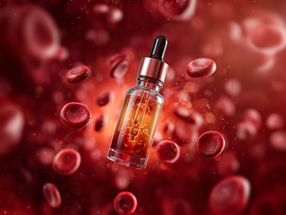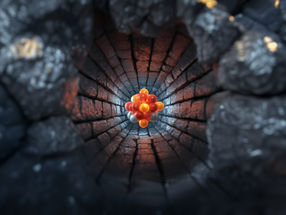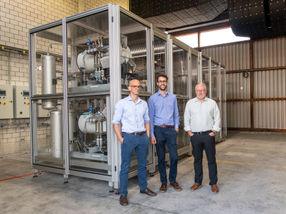Virtually indefinitely durable: the world's only heart valve prosthesis made from the body's own tissue implanted for the first time
Technology was transferred to the Berlin start-up GrOwnValve
At the German heart Center of the Charité (DHZC), a heart valve prosthesis made from the body's own tissue, the first of its kind in the world, has now been implanted. In contrast to conventional replacement valves made of animal material, it is designed to last almost indefinitely - and to adapt to the body's growth in children with congenital heart valve defects. This could prevent the need for stressful follow-up operations in future.
Diseases of the heart valves are among the most common acquired and congenital heart diseases. Every year, around 160,000 children worldwide are born with a defect in the pulmonary valve - the valve between the right ventricle and the pulmonary artery. In Germany, there are around 800 newborns per year.
Until now, prostheses have been available to replace this valve, the leaflets of which are made from animal tissue from cattle or pigs. However, these valves are only durable for a limited period of time and have to be replaced after a few years. In children, there is an additional decisive disadvantage: the replacement valves do not grow with the child and have to be replaced with a larger model every five to ten years. Each of these open heart surgeries means a considerable burden and longer hospital stays for the young patients.
PD Dr. Boris Schmitt, paediatrician at the German Heart Centre at Charité (DHZC), and his team have been researching a solution to these problems since 2010: Heart valves that are made from the body's own tissue and are therefore accepted by the immune system and, at best, adapt to the body's growth.
Innovative method combines longevity with gentle treatment
The procedure involves removing the patient's own tissue from the pericardium, forming the leaflets of the new heart valve and attaching them to a wire frame (stent). This is then compressed, placed in exactly the right position in the heart via a thin catheter under X-ray control and deployed there. The entire procedure takes just a few hours and does not require open heart surgery.
"The decisive advantage of our innovation lies in the use of the body's own tissue," explains PD Dr Boris Schmitt, paediatrician at Charité's German Heart Centre, who has been researching this method since 2010: "These valves are not recognized as foreign by the immune system. They are initially supplied with nutrients by the bloodstream and, over time, cell layers even form. The leaflets of the heart valve thus remain alive, as it were, and can regenerate and adapt to the body's needs. We therefore hope that these valves will last significantly longer than the models currently available, ideally for a lifetime."
Pioneering prospects for children with heart defects
The application of the technology is particularly promising for children with congenital heart valve malformations. A special stent is developed for this purpose, which dissolves in the body after some time. All that remains is the heart valve made of the body's own tissue, which is no longer limited in size by the wire frame. "In this way, we want to create the best possible conditions for the growth of the valve in children and adolescents that we hope for," explains Boris Schmitt.
Prof. Felix Berger, MD, Director of the Clinic for Congenital Heart Defects - Pediatric Cardiology at the DHZC, under whose leadership the project was developed, emphasizes: "With around 160,000 children worldwide being born with a pulmonary valve defect every year, this technology could mean a paradigm shift in the treatment of many of these children. We hope that this method will enable us to significantly reduce the number of open heart operations required."
After years of preliminary studies and complex approval procedures, the method has now been approved for use in humans. The current study (GECT-DZHK28) at the German Center for Cardiovascular Research (DZHK) is initially investigating the safety of the method in seven young adults with a congenital pulmonary valve defect. If the method proves to be feasible and safe, a larger follow-up study is planned, which will include children as well as adults.
First patient already able to work again
In the meantime, two patients have already been successfully treated. Marcus L. from Saxony, the first patient, was born with valve stenosis in early 1990 and underwent a so-called Ross operation in 2001, which included replacing his pulmonary valve with a valve made from animal tissue. 24 years later, this has to be replaced again. As an ideal candidate for the new procedure, he was informed about the innovative treatment option by Dr. Schmitt and his team.
"As a father of three and a self-employed painter and floor layer, I wanted to be fit for work again as quickly as possible, which is why I immediately opted for this new procedure," explains Marcus L. His calculations have paid off so far: He was discharged from hospital just five days after the procedure and returned to work four weeks later. "I feel great," reports the 34-year-old.
From research project to start-up
The technology was transferred to the Berlin start-up GrOwnValve, which was founded in 2019 by PD Dr. Boris Schmitt and Jasper Emeis. The company received a grant of 2.5 million euros and an investment commitment of 5.3 million euros from the European Union's EIC Accelerator program. These funds will mainly be used for clinical studies to prove the safety and efficacy of the procedure.
In addition, the German Heart Institute Berlin Foundation has supported the project for years by providing premises and infrastructure.
"The hope is to make this technology available in less developed or poorer countries," says Schmitt. "As the procedure does not require expensive artificial prostheses and uses the body's own tissue, it could be much more cost-effective and thus benefit thousands of children worldwide who would otherwise not have access to adequate treatment."
Future prospects for the technology
The procedure is currently only approved for the replacement of the pulmonary valve, i.e. the valve between the right ventricle and the pulmonary artery. In the future, however, following extensive testing, the technology should also be able to be used for other heart valves such as the aortic valve, which have to withstand higher loads.
Note: This article has been translated using a computer system without human intervention. LUMITOS offers these automatic translations to present a wider range of current news. Since this article has been translated with automatic translation, it is possible that it contains errors in vocabulary, syntax or grammar. The original article in German can be found here.
Other news from the department science
Most read news
More news from our other portals
Something is happening in the life science industry ...
This is what true pioneering spirit looks like: Plenty of innovative start-ups are bringing fresh ideas, lifeblood and entrepreneurial spirit to change tomorrow's world for the better. Immerse yourself in the world of these young companies and take the opportunity to get in touch with the founders.

